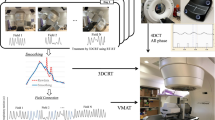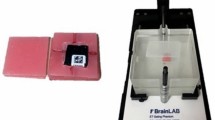Abstract
This study evaluated the impact of respiratory movement on four-dimensional computed tomography (4D-CT) acquisition and radiotherapy delivery. QUASAR™ Respiratory Motion Phantom with nine sinusoidal waveforms that combined three amplitudes (10, 20, and 30 mm) and three breaths per minute (BPMs) (10, 15, and 20) was used. We acquired 4D-CT for nine respective waveforms and measured and compared geometrical factors (volume, shape, and motion) to reference static CT. We optimized and delivered radiotherapy plans on a Vital Beam and evaluated gamma for dose distribution analysis with three acceptance criteria: 3%/3 mm, 3%/3 mm, and 5%/5 mm. Geometrical analysis revealed that an increase in amplitude decreased 4D-CT acquisition accuracy. Geometrical factors for an amplitude of ≤ 20 mm were within tolerance limits, however, amplitude 30 mm resulted in significant deviations over tolerance limits. BPM had a minimal effect on geometrical accuracy when accurate pitch values for respective BPMs were selected for scanning. Dose distribution analysis also indicated that an increase in amplitude decreased the gamma passing rates. Amplitude 30 mm failed to achieve a 95% passing rate for all three gamma evaluation criteria adopted in the present study. Overall, our results demonstrate that respiratory motion has significant effects on the accuracy of both 4D-CT acquisition and planned radiotherapy delivery. Small amplitude of ≤ 20 mm is required to ensure accuracy.







Similar content being viewed by others
Data availability
The data that support the finding of this study are available upon reasonable requests to the corresponding author (J.C.K.)
Change history
13 March 2024
An Erratum to this paper has been published: https://doi.org/10.1007/s40042-024-01026-6
References
S.T. Chao, L.K. Dad, L.A. Dawson, N.B. Desai, M. Pacella, R. Rengan et al., ACR-ASTRO practice parameter for the performance of stereotactic body radiation therapy. Am. J. Clin. Oncol. 43, 545–552 (2020)
C.B. Simone 2nd., B. Wildt, A.R. Haas, G. Pope, R. Rengan, S.M. Hahn, Stereotactic body radiation therapy for lung cancer. Chest 143, 1784–1790 (2013)
P. Kreinbrink, P. Blumenfeld, G. Tolekidis, N. Sen, D. Sher, G. Marwaha, Lung stereotactic body radiation therapy (SBRT) for early-stage non-small cell lung cancer in the very elderly (≥ 80years old): extremely safe and effective. J Geriatr Oncol. 8, 351–355 (2017)
B. Zhang, F. Zhu, X. Ma, Y. Tian, D. Cao, S. Luo et al., Matched-pair comparisons of stereotactic body radiotherapy (SBRT) versus surgery for the treatment of early stage non-small cell lung cancer: a systematic review and meta-analysis. Radiother. Oncol. 112, 250–255 (2014)
M. Guckenberger, N. Andratschke, K. Dieckmann, M.S. Hoogeman, M. Hoyer, C. Hurkmans et al., ESTRO ACROP consensus guideline on implementation and practice of stereotactic body radiotherapy for peripherally located early stage non-small cell lung cancer. Radiother. Oncol. 124, 11–17 (2017)
G.M. Videtic, J. Donington, M. Giuliani, J. Heinzerling, T.Z. Karas, C.R. Kelsey et al., Stereotactic body radiation therapy for early-stage non-small cell lung cancer: executive summary of an ASTRO evidence-based guideline. Pract. Radiat. Oncol. 7, 295–301 (2017)
M.W. Kissick, T.R. Mackie, Task group 76 report on “The management of respiratory motion in radiation oncology” [Med. Phys. 33, 3874–3900 (2006)]. Med. Phys. 36, 5721–5722 (2009)
S.B. Jiang, Technical aspects of image-guided respiration-gated radiation therapy. Med. Dosim. 31, 141–151 (2006)
I.S. Grills, D. Yan, A.A. Martinez, F.A. Vicini, J.W. Wong, L.L. Kestin, Potential for reduced toxicity and dose escalation in the treatment of inoperable non-small-cell lung cancer: a comparison of intensity-modulated radiation therapy (IMRT), 3D conformal radiation, and elective nodal irradiation. Int. J. Radiat. Oncol. Biol. Phys. 57, 875–890 (2003)
S.C. Erridge, Y. Seppenwoolde, S.H. Muller, M. van Herk, K. De Jaeger, J.S. Belderbos et al., Portal imaging to assess set-up errors, tumor motion and tumor shrinkage during conformal radiotherapy of non-small cell lung cancer. Radiother. Oncol. 66, 75–85 (2003)
Q.S. Chen, M.S. Weinhous, F.C. Deibel, J.P. Ciezki, R.M. Macklis, Fluoroscopic study of tumor motion due to breathing: facilitating precise radiation therapy for lung cancer patients. Med. Phys. 28, 1850–1856 (2001)
E.A. Barnes, B.R. Murray, D.M. Robinson, L.J. Underwood, J. Hanson, W.H. Roa, Dosimetric evaluation of lung tumor immobilization using breath hold at deep inspiration. Int. J. Radiat. Oncol. Biol. Phys. 50, 1091–1098 (2001)
E.D. Brandner, I.J. Chetty, T.G. Giaddui, Y. Xiao, M.S. Huq, Motion management strategies and technical issues associated with stereotactic body radiotherapy of thoracic and upper abdominal tumors: a review from NRG oncology. Med. Phys. 44, 2595–2612 (2017)
Y. Kwong, A.O. Mel, G. Wheeler, J.M. Troupis, Four-dimensional computed tomography (4DCT): a review of the current status and applications. J. Med. Imaging Radiat. Oncol. 59, 545–554 (2015)
C.L. Ong, M. Dahele, B.J. Slotman, W.F. Verbakel, Dosimetric impact of the interplay effect during stereotactic lung radiation therapy delivery using flattening filter-free beams and volumetric modulated arc therapy. Int. J. Radiat. Oncol. Biol. Phys. 86, 743–748 (2013)
M. Nakamura, Y. Narita, A. Sawada, K. Matsugi, M. Nakata, Y. Matsuo et al., Impact of motion velocity on four-dimensional target volumes: a phantom study. Med. Phys. 36, 1610–1617 (2009)
X. Li, E. Chen, B. Guo, W. Yang, R. Han, C. Hu et al., The impact of respiratory motion and CT pitch on the robustness of radiomics feature extraction in 4DCT lung imaging. Comput. Methods Programs Biomed. 197, 105719 (2020)
C.H. Pan, A.C. Shiau, K.C. Li, S.H. Hsu, J.A. Liang, The irregular breathing effect on target volume and coverage for lung stereotactic body radiotherapy. J. Appl. Clin. Med. Phys. 20, 109–120 (2019)
S.S. Jang, G.J. Huh, S.Y. Park, P.S. Yang, E.Y. Cho, The impact of respiratory gating on lung dosimetry in stereotactic body radiotherapy for lung cancer. Phys. Med. 30, 682–689 (2014)
R. Muirhead, C. Featherstone, A. Duffton, K. Moore, S. McNee, The potential clinical benefit of respiratory gated radiotherapy (RGRT) in non-small cell lung cancer (NSCLC). Radiother. Oncol. 95, 172–177 (2010)
O. Rouabhi, B. Gross, J. Bayouth, J. Xia, The dosimetric and temporal effects of respiratory-gated, high-dose-rate radiation therapy in patients with lung cancer. Technol. Cancer Res. Treat. 18, 1533033818816072 (2019)
G. Hilgers, T. Nuver, A. Minken, Helical 4D CT pitch management for the brilliance CT big bore in clinical practice. J. Appl. Clin. Med. Phys. 16, 5111 (2015)
A. Bezjak, R. Paulus, L.E. Gaspar, R.D. Timmerman, W.L. Straube, W.F. Ryan et al., Safety and efficacy of a five-fraction stereotactic body radiotherapy schedule for centrally located non-small-cell lung cancer: NRG oncology/RTOG 0813 trial. J. Clin. Oncol. 37, 1316–1325 (2019)
G.M. Videtic, C. Hu, A.K. Singh, J.Y. Chang, W. Parker, K.R. Olivier et al., A randomized phase 2 study comparing 2 stereotactic body radiation therapy schedules for medically inoperable patients with stage I peripheral non-small cell lung cancer: NRG oncology RTOG 0915 (NCCTG N0927). Int. J. Radiat. Oncol. Biol. Phys. 93, 757–764 (2015)
A. Niroomand-Rad, C.R. Blackwell, B.M. Coursey, K.P. Gall, J.M. Galvin, W.L. McLaughlin et al., Radiochromic film dosimetry: recommendations of AAPM radiation therapy committee task group 55. American Association of Physicists in Medicine. Med. Phys. 25, 2093–2115 (1998)
M. Miften, A. Olch, D. Mihailidis, J. Moran, T. Pawlicki, A. Molineu et al., Tolerance limits and methodologies for IMRT measurement-based verification QA: recommendations of AAPM Task Group No. 218. Med. Phys. 45, e53–e83 (2018)
G.A. Ezzell, J.W. Burmeister, N. Dogan, T.J. LoSasso, J.G. Mechalakos, D. Mihailidis et al., IMRT commissioning: multiple institution planning and dosimetry comparisons, a report from AAPM Task Group 119. Med. Phys. 36, 5359–5373 (2009)
E.D. Morris, J.P. Kim, P. Klahr, C.K. Glide-Hurst, Impact of a novel exponential weighted 4DCT reconstruction algorithm. J. Appl. Clin. Med. Phys. 19, 217–225 (2018)
P.J. Keall, G. Starkschall, H. Shukla, K.M. Forster, V. Ortiz, C.W. Stevens et al., Acquiring 4D thoracic CT scans using a multislice helical method. Phys. Med. Biol. 49, 2053–2067 (2004)
H.S. Grewal, S. Ahmad, H. Jin, Dosimetric study of the interplay effect using three-dimensional motion phantom in proton pencil beam scanning treatment of moving thoracic tumours. J. Radiother. Pract. 22, e11 (2023)
S. Goossens, F. Senny, J.A. Lee, G. Janssens, X. Geets, Assessment of tumor motion reproducibility with audio-visual coaching through successive 4D CT sessions. J. Appl. Clin. Med. Phys. 15, 4332 (2014)
R. George, T.D. Chung, S.S. Vedam, V. Ramakrishnan, R. Mohan, E. Weiss et al., Audio-visual biofeedback for respiratory-gated radiotherapy: impact of audio instruction and audio-visual biofeedback on respiratory-gated radiotherapy. Int. J. Radiat. Oncol. Biol. Phys. 65, 924–933 (2006)
W.A. Mampuya, Y. Matsuo, N. Ueki, M. Nakamura, N. Mukumoto, A. Nakamura et al., The impact of abdominal compression on outcome in patients treated with stereotactic body radiotherapy for primary lung cancer. J. Radiat. Res. 55, 934–939 (2014)
G. Bouilhol, M. Ayadi, S. Rit, S. Thengumpallil, J. Schaerer, J. Vandemeulebroucke et al., Is abdominal compression useful in lung stereotactic body radiation therapy? A 4DCT and dosimetric lobe-dependent study. Phys. Med. 29, 333–340 (2013)
J.A. Lee, C.Y. Kim, D.S. Yang, W.S. Yoon, Y.J. Park, S. Lee et al., Four-dimensional computed tomography based respiratory-gated radiotherapy with respiratory guidance system: analysis of respiratory signals and dosimetric comparison. Biomed. Res. Int. 2014, 306021 (2014)
G. Liu, F. Hu, X. Ding, X. Li, Q. Shao, Y. Wang et al., Simulation of dosimetry impact of 4DCT uncertainty in 4D dose calculation for lung SBRT. Radiat. Oncol. 14, 1 (2019)
G. Hugo, C. Vargas, J. Liang, L. Kestin, J.W. Wong, D. Yan, Changes in the respiratory pattern during radiotherapy for cancer in the lung. Radiother. Oncol. 78, 326–331 (2006)
Y. Seppenwoolde, H. Shirato, K. Kitamura, S. Shimizu, M. van Herk, J.V. Lebesque et al., Precise and real-time measurement of 3D tumor motion in lung due to breathing and heartbeat, measured during radiotherapy. Int. J. Radiat. Oncol. Biol. Phys. 53, 822–834 (2002)
S. Sarudis, A. Karlsson, J. Nyman, A. Back, Dosimetric effects of respiratory motion during stereotactic body radiation therapy of lung tumors. Acta Oncol. 61, 1004–1011 (2022)
A. Edvardsson, F. Nordstrom, C. Ceberg, S. Ceberg, Motion induced interplay effects for VMAT radiotherapy. Phys. Med. Biol. 63, 085012 (2018)
T. Gauer, T. Sothmann, O. Blanck, C. Petersen, R. Werner, Under-reported dosimetry errors due to interplay effects during VMAT dose delivery in extreme hypofractionated stereotactic radiotherapy. Strahlenther. Onkol. 194, 570–579 (2018)
P. Klahr, Evaluation of slice sensitivity profiles for helical and axial 4D-CT acquisitions on the Philips Brilliance CT Big Bore. Med. Phys. 41, 101909 (2014)
T. Pan, Comparison of helical and cine acquisitions for 4D-CT imaging with multislice CT. Med. Phys. 32, 627–634 (2005)
Y. Matsuzaki, K. Fujii, M. Kumagai, I. Tsuruoka, S. Mori, Effective and organ doses using helical 4DCT for thoracic and abdominal therapies. J. Radiat. Res. 54, 962–970 (2013)
Funding
None.
Author information
Authors and Affiliations
Contributions
Conceptualization, J-CK; data curation, BKB, SJK, and J-CK; formal analysis, BKB, SJK, and J-CK; investigation, BKB, SJK, and J-CK; methodology, BKB; project administration, J-CK; manuscript writing—original draft, BKB; manuscript writing—review and editing, BKB, SJK, and J-CK.
Corresponding author
Ethics declarations
Conflict of interest
The authors declare no conflict of interest.
Additional information
Publisher's Note
Springer Nature remains neutral with regard to jurisdictional claims in published maps and institutional affiliations.
The original online version of this article was revised due to a retrospective Open Access cancellation.
Rights and permissions
Springer Nature or its licensor (e.g. a society or other partner) holds exclusive rights to this article under a publishing agreement with the author(s) or other rightsholder(s); author self-archiving of the accepted manuscript version of this article is solely governed by the terms of such publishing agreement and applicable law.
About this article
Cite this article
Bae, B.K., Kim, S.J. & Kim, JC. Effects of respiratory motion on accurate four-dimensional computed tomography acquisition and plan delivery for lung stereotactic body radiation therapy. J. Korean Phys. Soc. 84, 323–334 (2024). https://doi.org/10.1007/s40042-023-00986-5
Received:
Revised:
Accepted:
Published:
Issue Date:
DOI: https://doi.org/10.1007/s40042-023-00986-5




